
 |
Environmental standards for museums |
The header to this page refers to several articles, lectures and published papers which question the apparently unquestioned emphasis on constant temperature in nearly all museum standards. There is no evidence that a gentle annual temperature cycle does harm, but it would greatly simplify climate control and reduce its energy use.
Jump to the summary and conclusions
Environmental standards for museums and archives uphold the noble ideal: do no harm.
However, the conservation profession devoted to preserving the relics of the past has a tiny proportion of scientists, who are expected to understand the deterioration processes of all materials and constructions ever used by mankind, as well as biological specimens, fossils and minerals.
It is small wonder that most standards for museums merely take the indoor climate as humans like it and narrow its variation, on the principle that constancy of temperature and humidity cannot do harm to an inanimate object.
So the standards also embody a more doubtful ideal: use the best available technology to achieve constancy of climate.
At the height of this approach, by around 1990, the best available technology could achieve a temperature constant throughout the year within about 2 degrees of a set point, typically 21°C. The relative humidity (RH) cannot be controlled quite as well, mainly because of drift in the sensor, so the limit is set 5% from a set point typically at 50%.
The recourse to best available technology was extended to air pollution. The innumerable acceptable limits in the literature are just what could be measured at the time of publication.
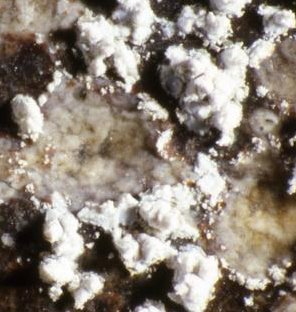
Corrosion of an engraved lead plate exhibited in an oak showcase
The vulnerability of modern materials is studied by a huge industrial research community. It has decided that the dangerously ephemeral records of modern humanity, embedded in immediately accessible, but tender formats, such as colour film, and in only indirectly understandable formats, on magnetic tape and compact disks, require storage conditions much cooler than humans can long endure. The parallel need for maintaining obsolete interpreting and digital conversion machinery is a matter outside the scope of this gentle polemic.
The poor durability of these modern materials has led to a tendency to precautionary extreme cold, around -20°C is often invoked.
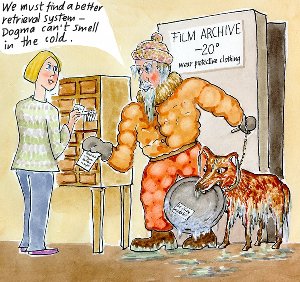
In summary - museum environments fall into two groups: the warm rooms with a climate comfortable to humans and the cold rooms with an intolerable climate for humans. In standards for both these environments, a constant temperature and RH is required.
Museums are so rare and so central to our communities that an obsession with saving energy is a deeply wrong setting aside of the duty to preserve, just to make a public statement of virtue, with no quantitative effect in saving the world. It is like the wartime encouragement to house owners in England to cut down their garden railings to melt down for guns.
However, there are better reasons for doubting the advice of our present environmental standards.
The warm climate, cosy for humans, recommended in countless tiny variations by various authors, has done harm. Mostly to the buildings containing the historic relics. The dew point of this climate is 10°C. In temperate climates the outside temperature, and therefore the outer temperature of the building, particularly if it is well insulated, often falls below this dew point, so the critical temperature is within the building structure. Hidden condensation has damaged many air conditioned building. One of the most dramatic declines is the Arts and Industries Museum of the Smithsonian Institution, re-roofed in 1976, now so damaged that it is closed to visitors for fear of roof collapse.

Arts and Industries Museum, Washington DC
The toll of minor injuries to buildings is immense, though often no more dramatic than rotting sills below windows with dribbling condensation.
The danger is much diminished by allowing the temperature to drift down in winter, together with the RH. The RH should be a bit lower at a low temperature anyway, to maintain a constant water content in absorbent materials. At a perfectly habitable 16°C and 40% RH, the dew point is 2°C. This seldom causes structural damage to buildings. As a byproduct, it saves a lot of energy and reduces thermally mediated degradation of materials. If the summer temperature is allowed to rise to 24°C, and the RH to 60%, much energy is also saved in summer, though the rate of degradation is increased. Such a regime will, in many places in the temperate zone, allow the use of winter heating alone, without air conditioning. Designing for high thermal and moisture inertia will reduce the daily variation which is customarily prevented by air conditioning.
So what is the consequence of allowing the temperature to drift with the seasons? Do we accelerate damage to the artifacts? Nobody knows, because the climate is still so benign that there is no experimental evidence for deterioration. Scientists use two approaches: extrapolation of high temperature damage using activation energy theory, and elegant techniques to detect single molecule reactions. While we await a critical mass of convincing results from these investigations, we have to resort to the evidence from archaeology and history.
Archaeologists have not been as diligent as we would wish in recording the climate around their finds. But one can indirectly deduce that the ancient library of St Catherine's Monastery in Sinai, Egypt, has endured with resilience temperatures between 30°C and 8°C, and RH varying from 10% to 30%, since the sixth century. The paper relics recovered in perfect condition from the desert of Turkestan seem to have been exposed to an annual cycle of -10°C to 25°C and a RH between 30% and 50%, since the third century.
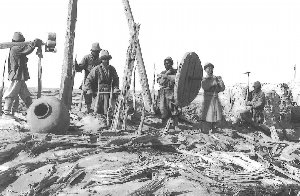
Sven Hedin's desert excavations, 1901
One can approach the matter from the other direction and ask what extremes of temperature and RH definitely cause damage fast enough to be noticed within a human career period. Less than 10°C embrittles some materials, particularly acrylic paint, making them very vulnerable to handling. Nevertheless, it is common practice for conservators to plunge artifacts suddenly to -30°C to exterminate bugs that may not be there, while insisting in the loan contract on strictly defined environmental standards.

The temperature sensitivity of acrylic paint [Mecklenburg]
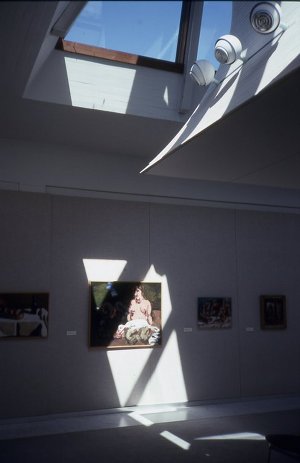
Aalborg Art Museum, Denmark
The lighting standard also lacks scientific credibility. It establishes a set of maximum lux values for light falling on various sensitive materials, mostly dyes and watercolours. The lux is a measure of the rate of the (reversible) photochemical reaction of the pigments in the human eye. Artifacts react differently, being mostly damaged by blue light. So for a given lux value, one can expect a twenty times slower reaction rate under incandescent light, compared with north daylight. This makes the standard division into 50 lx and 200 lx categories insignificant, unless the nature of the light source also is specified. How did this happen? Simply because the measurement of light intensity became possible before it became convenient to measure the spectral energy distribution falling on an object. Once again, best available technology set a standard that is now obsolete, but unlikely to die soon because conservators, like all of us, cling to tradition long after it has lost its justification.
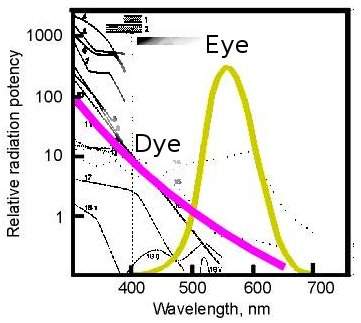
[Adapted from Michalski]
A different approach to setting limits to the acceptable environment is taken by the risk analysers. Their contention is that everything damages - what counts is deciding which is the most serious cause. They mix up risks like fire, which may never happen, with certainties like light damage and thermal degradation of polymers, which always happen. With math one can solve all problems except the fundamental problem that we do not know much about decay rates of artifacts. The range of durability is immense: from unfixed photographs that will fade under the brief flash used to copy them to the paper buried for nearly two millenia in the central Asian desert, without significant damage.
There are interesting variants on the risk analysis approach, designed to provide quantitative information. Michalski presents the concept of proofed exposure: that an object can resist a repeat excursion to a transient climatic extreme to which it has already been exposed, without further damage. Other experts combine this with experiments to find the average natural climate to act as a centre point for defining acceptable excursions. The National Gallery London discovered this central value by hanging blocks of wood in the galleries for a year. The proofed exposure concept is certainly scientifically sustainable, Mecklenburg has demonstrated it for craquelure in painting. Unfortunately, a conservator will fill in the cracks with varnish and reset the sensitivity, but may not reset the relevant record in the eternally durable database necessary to establish the current value of the maximum permissible excursion. Anyway, the concept does not apply to chemical deterioration, which accelerates at high temperature, regardless of how often that temperature has been reached. So I only see a limited scope for this concept.
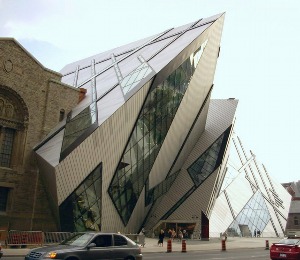
Royal Ontario Museum
The standards are vague on defining the properties of the building envelope which will contain the climate that they advocate. For a long time now (maybe always), new museums have mostly been designed for the prestige of the architect and the owner, with scant attention to environmental control. An extreme example is the extension to the Royal Ontario Museum, which has air conditioning piped to individual showcases, since the building cannot cope.
It is defeatist to assume that if the environmental standards are relaxed to allow an annual cycle of temperature and RH, one needs to invoke risk analysis to justify the presumed inferior environment. There is no reason to expect catastrophe from implementing an indoor climate regime which yields to the seasons of the outside world. However, to ensure a moderate rate of change, the standards need to assert minimum values for thermal and moisture resilience, commonly called buffering. One can achieve a safe environment without air conditioning in many places on earth.
The way standards are developed and maintained must be changed. We have a historic system in the UK where one institution, the BSI, provides prestige and a secretariat, producing standards at a high price per page. The standard itself, however, is the work of an unpaid committee. There is a need for a paid researcher to assemble the supporting scientific evidence. I suggest a wiki style of open debate leading to development of a standard whose authors are named as people, rather than as institutions, and whose deliberations are not secret. I cannot see the BSI providing this service. Maybe ICON (UK Institute for Conservation) or IIC (International Institute for Conservation) would offer a web service. The European CEN array of standards is making very slow progress, again with no exposure to the opinions of those outside the charmed circle of participants. It is also burdened with a complicated structure and rules of conduct. The north American approach seems to be to funnel standards through ASHRAE. I think this is a bad idea, because ASHRAE is a trade organisation, devoted to spreading elaborate hardware into every building. There is a clear conflict of interest. An open debate towards consensus seems an option worth trying. Finally, all our standards should be licenced "creative commons-no derivative works", so everyone can read them, and find in the appendices the reasons why they are reasonable.
1. Scope: I suggest that the standard should be limited to objects which are entirely indoors. Buildings, and objects attached to outside walls, such as church frescoes, cannot usefully be protected by standards. Accreditation of experts would be an alternative approach for safe care of these historic monuments.
2. Universality: The standard should apply to all objects regardless of their formal context: a paper document in an archive should not be protected differently than a water colour painting in an art gallery. Degradation processes are probably the same all over the universe, so different countries should only have different standards on account of their different climates, and the differences should be minimal.
3. Modularity: the environmental standard should be formulated so it can be slotted into more comprehensive standards that cover fire and theft protection, ventilation needs of people and many other details required for specifying a museum environment.
4. Scientific evidence for degradation processes. There must be an appendix reviewing, with critical appraisal, the literature on the degradation pathways which are influenced by environmental factors. The authority of the standard must rest on this accumulated knowledge rather than on the status of committee members or their employers.
5. A simple division of artifacts into those which can endure a climate congenial to humans, those which require encapsulation in a showcase to reduce RH variation (temperature change can hardly be prevented by enclosure) and those which require a climate which humans cannot tolerate (which will surely always be colder). More elaborate guidance on which category to place particular artifacts would be useful, but should be in an appendix.
6. The recommended environment, expressed in several sets of figures: ideal values; safe range; expected exceptions expressed as permitted percent of time over-range; alarm limits. The controlled variables are: temperature, relative humidity (may be linked), air pollution, air leakage, light (maybe object luminosity), radiant energy distribution, lighting efficiency.
7. Specification for new buildings which will provide a basic climate stability. The climate may be enhanced by mechanical means but the building must provide a naturally fail-safe container for the artifacts. (Advice on retro-fitting old buildings should not be in the standard but in separate architectural advisory publications). Key phrases: thermal diffusivity of the building envelope, moisture buffer capacity of the building.
8. Specification for modern materials used around historic artifacts, such as shelves, boxes and showcase components. They must not outgas aggressive molecules. This is so difficult to measure and define that a simple limit on the total volatiles permitted is probably the best approach, and will not in practice unfairly exclude materials of good character.
9. Rules for negotiating loans from one climate to another (for example from Australian summer to European winter) if the present demand for strict temperature uniformity is relaxed.
10. Requirements for quality control. The climate must be measured and the measuring instruments must be calibrated. The data must be stored in a durable format, both on paper for ultimate durability (but poor accessibility), and also digitally in an open format (such as comma separated ascii tables), to allow re-working and display in different ways. The required parameters are temperature and relative humidity, energy use for air conditioning and, separately, for lighting. There will also be a list of recommended (but not required) measurements: outside temperature and RH, carbon dioxide, air exchange rate (in which case also wind direction and speed), selected pollutant concentrations, visitor numbers.
11. An expiry date for the standard - forcing regular revision.
A. The scientific underpinning of the standard
B. How to choose the environment suitable for an individual artifact
C. Choosing modern materials for encasing ancient artifacts. Measuring gaseous emissions.
D. Air filtration technology and maintenance.
E. Cold storage: acclimatisation guide for retrieving and replacing artifacts.
F. Environmental measurements: principles, choice of sensor, calibration.
G. Preservation and presentation of environmental records.
H. Bibliography with recommended background reading (this is distinct from appendix A, which is the academic evidence for decay rates).
The development and revision of standards, such as the British archive standard and the European standards is a slow and cumbersome process, because of bureaucracy and expense, and I suspect because of the difficulty of getting volunteers to get moving with what they have offered to do. The details that need to be changed in existing standards are really simple and not controversial. Allowing an annual cycle in temperature (about 14 to 24 degrees in UK) would vastly reduce the complexity and running cost of climate control. Allowing a higher summer maximum temperature and a lower winter minimum relative humidity (35%) would remove both the standard-enforced and the real need for air conditioning in nearly all museums in temperate climates. Objects thought to be sensitive to RH change can be enclosed in simple showcases or boxes which can buffer passively to the annual average RH. We must devise a way to remove the unreasonably tight temperature and RH restrictions from existing standards without wasting years on formal debate and procedural intricacy.
A pictorial presentation of this article (pdf)
A closer look at the environmental component of British Standard 5454 for archives.
Tim Padfield, 2009-04-09

This work is licensed under a Creative Commons Attribution-Noncommercial-No Derivative Works 3.0 License.